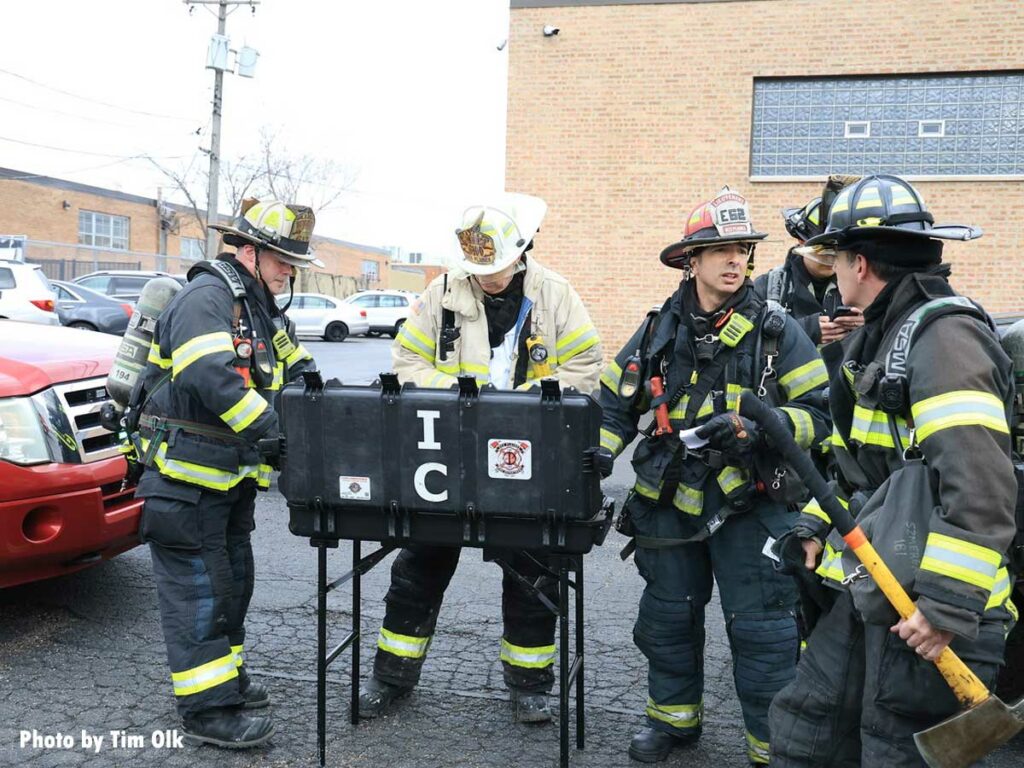
By Ben Perry
Firefighters are routinely tasked with tackling some of the most demanding and complex situations in the service of their communities. We are second to none at succinctly communicating needs, developing priorities, working in teams, and executing assignments during emergency situations. However, when it comes to addressing internal programs, such as the department’s strategic planning and execution, firefighters may struggle to apply those same fireground principles and to achieve a favorable outcome.
The main fire challenges departments may face when they approach strategic planning can often be attributed to financial constraints, poorly defined or prioritized objectives, inadequate communication, and internal or external politics. These problems are further exacerbated by a lack of vision, leadership, or follow-through. Navigating these issues can be daunting, but departments that understand the root cause of the problem and take a purposeful approach to problem-solving can overcome them. By proactively addressing these challenges, departments may be able see progression of their strategic objectives, and ultimately better serve their communities.
- Strategic Planning for Training and Professional Development
- The Leader’s Vision Must Be Accurate
- STRATEGIC PLANNING FOR THE DEPARTMENTS: AN INTRODUCTION
- A STRATEGIC PLANNING MODEL FOR FIRE DEPARTMENTS
Let’s look at a few of the critical components to leading a team through strategic planning, and unpack how you and your team might approach them.
Vision
It all starts with a clear vision. Just as on the fireground, leaders must be able to visualize a best-case-scenario and guide their team accordingly. Department leaders should begin by gaining a thorough understanding of their mission, responsibilities, and stakeholder expectations, as well as assessing their current performance against those elements. Based on this, leaders should then formulate a clear vision for their department’s ideal state. The scope and detail of this vision might vary based on the department’s current performance level. Higher-performing departments may be able to project a vision with a longer timeframe or greater clarity. This clear vision will serve as a guide for decision-making and should be aligned with the department’s mission and values. It’s crucial that this vision is communicated to all members of the department to ensure that everyone is rowing in the same direction, which is essential for taking the next steps on this journey.
With a clear vision established, department leaders can then turn their attention to setting specific goals and objectives that align with that vision. The process of creating a vision should be completed before crafting goals and objectives, because it serves as a foundation of the department’s efforts towards a common goal. While it is beyond the scope of this article to provide detailed instructions on how to create these goals and objectives, there are many resources available that can guide leaders through the process.
Prioritization
Prioritizing strategic goals and objectives is essential for making progress and ultimately reaching the vision. This process can be translated easily from the fireground, where we are challenged to pick the most impactful issues to get after first. There are several ways to prioritize goals, such as using the Eisenhower Matrix, the Pareto Principle, or the MOSCOW method; each one of these methods have their own advantages.
The Pareto Principle, also known as the 80/20 rule, is particularly useful when prioritizing. It states that 80% of the effects come from 20% of the causes. Applying this principle to strategic planning involves identifying the 20% of goals, objectives, or tasks that will have the greatest impact on the department and prioritizing them.
It’s important to remember that when it comes to prioritization, there can only be a single number one priority. If everything is a priority, then nothing is a priority. Additionally, it’s important to avoid categorizing priorities too broadly as it can lead to poor communication of which components of each priority should come first. That said, if tasks are divided up to be worked by different teams, they should each have their own priorities informed by the master priority list. That means each team can be working their own tasks simultaneously unless they would be pulling resources from one another (like a human resource department’s bandwidth, which may be limited), where the master priority list would then help to deconflict. It’s essential that each team understands which of their tasks are of the highest importance and should be tackled first.
Responsibility
Determining who will take responsibility for each specific strategic priority is perhaps the single biggest factor to success. It’s no different than on scene: if the incident commander gives unclear instructions or assignments, it could lead to confusion or even disaster. If it is unclear who is ultimately responsible for a given topic, it is easy to have a breakdown in communication that leads to either conflict over many people believing they are the decision maker, or, more commonly, neglect, with people believing that someone else will handle it. Assigning a single individual as the champion and principal coordinator for each individual item will ensure that there is the right amount of buy-in, leadership, and oversight over the department’s strategic efforts.
Action
Setting priorities and assigning responsibility are essential, but they are not enough on their own. To achieve strategic goals and objectives, it is necessary to have a well-defined plan of action. Just as a fireground leader might rally the team, listen to status reports, and then talk though a tactical approach to the next objective, strategic plan leaders must prepare their key players with a coordinated plan of attack to get after their assigned tasks. This is where it’s vital to have a good “coach” overseeing the strategic efforts, deconflicting projects that may compete for resources or attention, and continually motivating and providing feedback to those doing the work.
No plan survives first contact with the enemy. —Helmuth von Moltke
Being a paramilitary organization, we can borrow a lot of wisdom from the military. One popular saying in military circles is: “No plan survives first contact with the enemy.” As your team gets started chipping away at tasks, they will inevitably run into roadblocks and unexpected challenges. One way to get ahead of this will be to deliberately encourage flexibility, create space for failure, and empower the team to seek alternative solutions. You will be amazed at the creative approach’s firefighters will take once they know they are truly empowered and supported, regardless of the outcome.
- Creating a Vision for Your Fire Department
- The Dynamics of Change Leadership in the Fire Service
- The Art of Planning
- Master Planning and the Planning Continuum
- Leadership Excellence: Communicate Your Vision
Collaboration
Firefighters likely understand the value of working in teams more than most. Much of what we do day-in and day-out is done either as a small team (like a single company) or a larger team (like one or more stations). That said, we are not immune to creating silos, building walled-kingdoms, or failing to consider other perspectives—especially the further we get from the fireground. As we drive our strategy from vision to plan to action, we must make a conscious effort to share the intent for early and often collaboration across teams. This collaboration is not just within the subgroups working on individual efforts, but should be encouraged at all levels. Sharing strengths, resources, and perspectives across teams will add value and reduce friction as they approach each task. Just like on the fireground, more eyes and more hands at a tough job will usually decrease risk and lighten the load.
Communication
Hand in hand with collaboration is effective communication. It’s not enough to just ask for help when you need it. Just like a C.A.N. report, giving regular updates to your team and department leaders is a great way to communicate needs, stay on track, and receive the feedback needed to remain agile in the journey towards completion of your assigned tasks. This battle rhythm will vary for different teams and in different seasons. Earlier in a project, the team may need significantly more feedback than towards the end. Likewise, teams that are working on projects they are specialized in could require less regular communication than a team tasked with something more outside their usual scope or specialty.
One leadership-driven opportunity related to communications is to encourage transparency and truthfulness, even in failure. In the book Outward Mindset by The Arbinger Institute, the authors highlight a story about Alan Mulally as he took the helm of Ford. In this story, he encounters status meetings in which the executives never brought any problems to the table—
all their charts were green. The story goes on to highlight how he encouraged, and even challenged them, to bring their problems into the light—to show the red. Once his team got on board, they saw the advantages that painting a transparent picture really had, receiving support, ideas, and resources from teammates. Back in your department, consider ways you can champion transparency, create space for setbacks and failures, and encourage richer collaboration.
*
The fireground is a unique ecosystem of communication, teamwork, adaptability, ingenuity, prioritized task execution, and selfless service. Fire service leaders in the conference room would do well to adopt these traits when approaching issues like a department’s strategic planning cycle. Things don’t always go as planned, and the team will inevitably run into roadblocks along the way. By creating an environment with a clear vision, clear expectations, continuous feedback, and multiple perspectives, you may see the strategic goals and objectives of the department come to life both better and faster than you could have ever imagined. Finally, just like the ice cream with dinner after a shift well-done, don’t forget to celebrate the team’s successes as they make progress on the planning and execution efforts. There will always be more to be done, and it’s your job to make sure your team is recognized, rested, and ready for the next challenge to come.

Ben Perry is a master sergeant in the U.S. Air Force, currently stationed at Joint Base San Antonio, Texas. He is a deputy fire chief with more 16 years in public safety. He is also the co-founder and host of The FireDawg Podcast (www.firedawg.us) that publishes podcast episodes and other content for the fire emergency services community.

